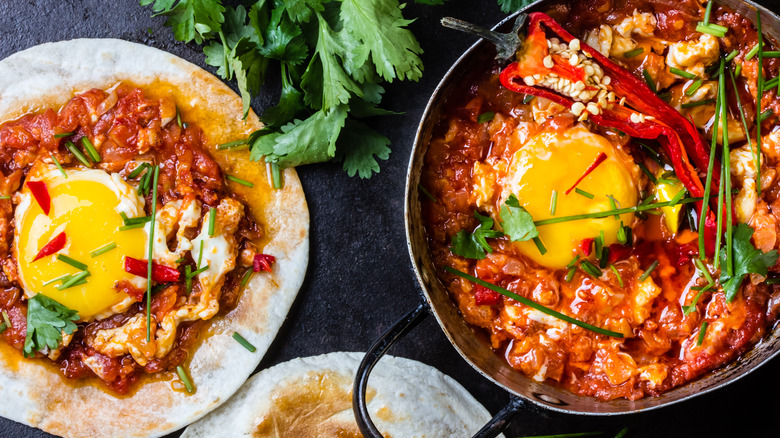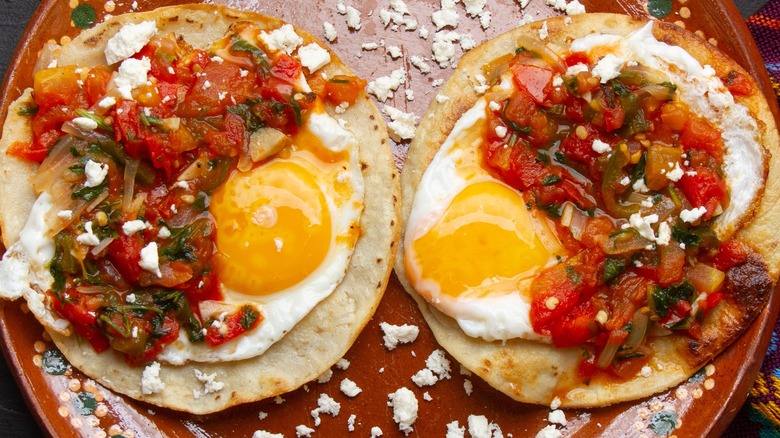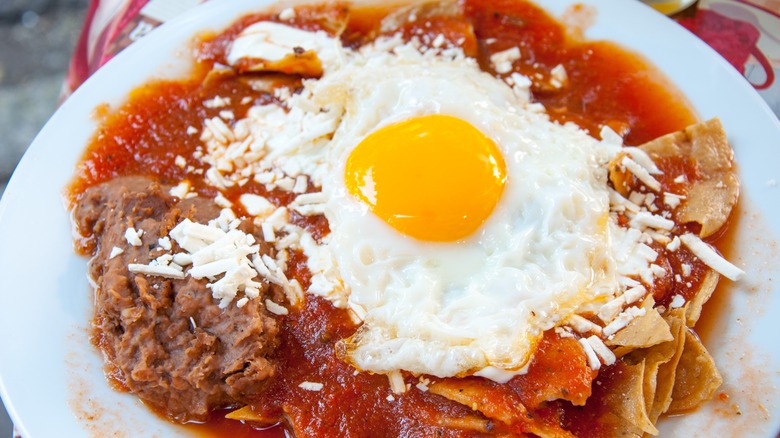What Separates Huevos Rancheros From Chilaquiles?
Served for breakfast, brunch, or a mid-day big meal of the day — aka a comida –huevos rancheros and chilaquiles are inexpensive, delicious, quick-to-prepare Mexican dishes that are popular all over the world. Although both recipes share some ingredients and even look similar at first glance, a big difference sets these saucy, eggy treats apart. Regional variations abound, but generally speaking, what distinguishes them is the base.
In Spanish, huevos rancheros translates to "rancher's eggs." Traditionally, the simple dish contained three ingredients commonly found in rural Mexican homes: eggs, tortillas, and salsa. Fried eggs (the huevos) are served on warm tortillas with a cooked tomato salsa (ranchero sauce) spooned on top. Depending on where it's prepared, huevos rancheros may also include pinto beans, rice, avocado, or fried potatoes to bulk up the already-hearty breakfast.
In contrast, chilaquiles are prepared with fried tortilla chips, traditionally made to use up ones that have gone stale. Enjoying this dish feels more like eating chips and salsa garnished with fried eggs. The chips are mixed with ranchero sauce until softened, then more cooked tomato salsa is ladled into shallow bowls. The base is topped with a fried egg or two, then garnished with crema, grated cheese like queso añejo, and diced raw white onion. You can't go wrong with ordering either dish — and preparing them at home offers even more room for fun customizations.
The history of both dishes
The origin of huevos rancheros likely dates back to 16th-century rural Mexico when the dish was traditionally served on farms and ranches as a mid-morning, second breakfast to refuel farmhands who had already put in hours of labor. Like Italy's cucina povera, this was a frugal recipe created to prevent waste, using leftover tortillas, a staple of the cuisine, and farm eggs. Regional variations added locally sourced ingredients like plantains in Oaxaca and rice in Chihuahua since the grain grows along the banks of the Rio Grande River.
Similarly, chilaquiles were created to repurpose stale tortillas. Although the first mention of chilaquiles is in an 1821 cookbook, the dish can be traced back to the Aztecs in the 15th century, predating huevos rancheros. The entomology of chilaquiles is rooted in three Nahuatl words, the language spoken by Aztecs — 'chili,' 'atl' (water), and 'quilitl' (edible herb). When the Spaniards colonized Mexico in the 16th century, crema and onion were incorporated into the recipe, creating the dish we recognize today.
Since Texas was part of Mexico until 1836, it's easy to see how the U.S. was introduced to these dishes. It's believed that Americans first experienced huevos rancheros via San Antonio, Texas, and that Encarnación Pinedo's cookbook, "The Spanish Cook," took chilaquiles over the border in 1898. Naturally, once the recipe was adopted in the new country, additional variations were created.
Tips for preparing huevos rancheros and chilaquiles
Since eggs cook quickly, it's essential to have the recipes' additional components ready before frying them. Start with the salsa, which can be used to prepare either recipe. Alternatively, make a green chile sauce using roasted tomatillos for a tangier dish. If in season, roast fresh tomatoes; otherwise, a can of fire-roasted tomatoes is delicious and eliminates a step.
Combine them with sauteed onions, garlic, and chilis in a blender and puree the sauce until smooth. It should be slightly thinner than marinara, so use stock to thin it out if necessary. Chilaquiles require more ranchero sauce than huevos rancheros, about a cup per serving, so plan ahead and freeze what you don't use. In a pinch, you can puree and heat a jar of your favorite salsa with two cups of chicken stock to prepare the recipe in seconds.
Freshly made corn tortillas are always ideal, but if you don't want to prepare them, purchase a bag from a nearby Mexican restaurant or tortillera. If you use store-bought chips to prepare chilaquiles, take note that they get soft quickly. How soft you want them is a matter of preference, but if you want them to retain their texture, keep an eye on them.
Right before serving, fry the eggs to finish either dish. If you prefer scrambled instead of fried eggs, try another Mexican favorite, Roberto Santibanez's miga recipe.
Static Media owns and operates Food Republic and Mashed.



